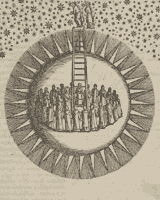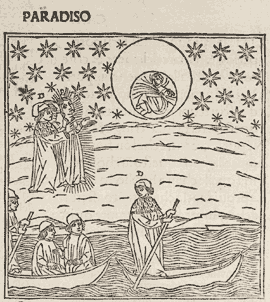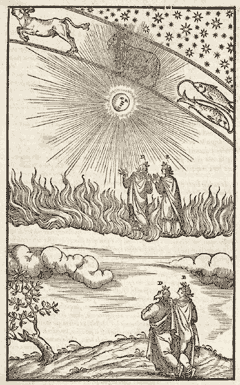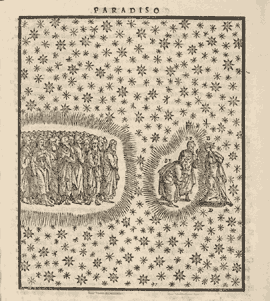|
|
Staring at the sun |

|
... almost
all of that hemisphere was white-while ours
was dark-when I saw Beatrice turn round
and left, that she might see the sun; no eagle
has ever stared so steadily at it.
(Paradiso I, 44–48, trans. Mandelbaum)
|
Dante and Beatrice entering the sphere of the fixed stars
(Venice: Francesco Marcolini, 1544). CUL SSS.56.5
|
|
|
The Paradiso has often appealed less to the visual imagination of illustrators than
Dante's graphic description of the tortures of the damned in the Inferno or of the souls
in the Purgatorio. It was 1491 before it received its own cycle of illustration in a
printed book—the beautiful Brescia edition of 1487 had woodcuts for all the cantos of
the first two books, but only one for the Paradiso. In Vellutello's edition of 1544,
however, the woodcuts for this part of the poem are especially fine.
Just as Hell and Purgatory can be mapped, so can the action of the Paradiso be located
in terms of the medieval cosmology of Dante's day. Dante and Beatrice leave the Earthly
Paradise at the top of Mount Purgatory and ascend to the stars, travelling through the
nine concentric spheres of the visible heavens to the Empyrean, the invisible heaven of
light and love, the home of the blessed and of God.
|

|

|
|
Frontispiece to Paradiso (Venice: Francesco Marcolini, 1544).
CUL SSS.56.5 [this image not on display]
|
|
Woodcut illustrating Paradiso II
(Venice: Petrus de Plasiis, Cremonensis, 1491). CUL SSS.10.1 [item not on display]
|
 |
| Beatrice and Dante conversing with Saint Peter
and Saint James, Paradiso XXV (Venice: Francesco Marcolini, 1544). CUL SSS.56.5
[this image not on display] |
| |
|
|